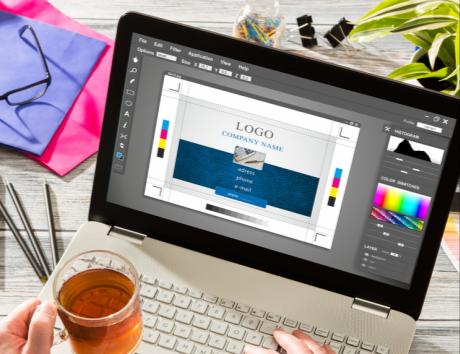How to Craft an Outstanding Creative CV: A Comprehensive Guide
When applying for a job, you want your CV to create a long and lasting impression. In particular, if you’re applying for a job in a creative industry (design, art, media, and so on), a traditional CV may not cut it. That’s when a creative CV can help you stand out from the crowd. Creative CVs showcase design skills and a creative mindset, and can show employers that you have the necessary skills and qualities for creative roles. Positions and industries where a creative CV might make a strong impact include graphic design, photography, filmmaking, web design, marketing and any role in media.

Are you ready to dazzle employers with your creative skills and put yourself ahead of the competition with your job applications? Read on to find out more about crafting an eye-catching and memorable creative CV.
Understanding the role of a creative CV in your job search
A creative CV can play a significant role in your job prospects for certain roles and industry sectors. Applications for any positions that require creative skills, or where visual presentation is important, could benefit from a creative CV. For modern industries, or sectors that require an innovative approach, creative CVs can be similarly effective.
Creative CVs can either be the main document in your job applications, or could be submitted alongside a more conventional CV, as a means of showcasing your design and visualisation skills. It’s still important to develop a more formal, professional CV using standard CV templates and formats, as these can form the foundation of your job search activities. However, for the appropriate role and in the right circumstances, a creative CV can be a powerful asset to have in your job search toolkit.
It’s important to understand when and where is the most suitable situation to submit a creative CV, and to know when a more conventional approach might be more effective. Generally, a creative CV can be effective for:
- Entry-level positions where you want to stand out from the crowd
- Mid-level roles where design or presentation skills are particularly valued
- Positions with forward-thinking, innovative and creative companies
On the other hand, creative CVs might be less effective for:
- Senior, strategic roles where you’re unlikely to need to showcase design skills
- Administrative positions where the work is less creative
- Formal, traditional professions that value a more conventional approach
EXPERT TIP
Advantages of a creative CV
With hundreds of applications received on average for a single sought-after position and recruiters spending just a few seconds scanning CVs, a creative CV can be a great way to stand out from the crowd.
For instance, creative CVs can help highlight web development skills for online CVs, filming skills for video CVs and design skills for 3D CVs. Furthermore, a creative CV shows initiative and that you’ve gone the extra mile. Employers and recruiters will immediately see how much time you have put into creating your CV and take it as an indication of your enthusiasm and passion for the job.
Disadvantages of a creative CV
Creating a creative and original CV can take a lot of time. If the deadline for your desired job is approaching, then you’re better off updating your traditional CV.
Making adjustments to your creative CV to match the position as closely as possible isn't always easy. For example, a video CV will need to be re-recorded, a package CV reprinted and an infographic updated. Of course, with speculative applications, you’ll have more time to make these changes.
The main disadvantage of a creative CV is that it may not pass the ATS (Applicant Tracking System), which many companies use at the first stage of an application process. These systems screen CVs for keywords that indicate whether a candidate has the required skills and experience.
Crafting a creative CV: a step-by-step guide
If you want to produce a creative CV that really enhances your job prospects, follow this step-by-step guide:
- Draft your CV: The first step to making a creative CV is typically to write a traditional, more formal CV that you can use as a foundation for your creative CV design. Write a traditional CV, tailored for the role you’re applying for, then adapt the content, introducing visual elements to replace or supplement the text according to your requirements.
- Settle on a colour palette, fonts and other key design elements: When making a creative CV, it’s essential to decide some of the basics of your document’s visual design language before you go ahead and start creating. This means picking a structure and some key design features, such as fonts, colours, icon sets and other visual elements.
- Create graphics and visualisations: Once you have the basics of your CV design sorted, you can move onto any bespoke designs and graphics. These might include graphs, tables, data visualisations, examples of your design work, photographs or other visual elements that tell a story about your career, achievements and skills.
- Optimise your CV for ATS: One of the risks of a creative CV is that it may fail to pass ATS screening stages. Ensure your creative CV has well-defined headings and plenty of text reflective of job description keywords.
- Proofread your creative CV: While the visual elements of a creative CV are critical to your chances of success, it’s also essential not to neglect your written content. Basic errors in spelling and grammar can still negatively effect your chances, even in a creative CV, so proofread it carefully before sending.
Balancing creativity and professionalism in your CV
In conservative industries (banking, law, medicine, etc.) or work environments (e.g. office management or administration), it’s probably not appropriate to send a creative CV. In those cases, you can still enhance the visual appeal of your CV a little by using colour or introducing subtle design elements. However, it’s still best to stick to neutral colours (black, blue, grey, silver, dark purple) and avoid making your CV too bright, bold or creatively focused.
If you’re not sure whether to make use of colour and design in your CV, take a look at the company’s website to get a feel for the tone, wording and imagery used. You will soon see whether a creative CV would be appropriate. As a rule of thumb, if a company has a formal dress code, then a creative CV will probably not be welcomed.
Too loud, too funny or too focused on yourself, and your creative CV can work against you. So, make sure that your creative CV adds value to your application by showcasing particular design and presentation skills that will serve you well in the role.
While it’s fine to emphasise your creative or out-of-the-box thinking skills with your CV, ask yourself whether these are required for the position you’re applying for. If not, err on the safe side and stick to a text-based CV with a more simple, traditional format and design.
Matching a creative CV to your personality
A creative CV isn’t for everyone. If you’re a shy and retiring person, then a CV with a bold design will probably look out of place and leave hiring managers confused. In that case, it’s better to opt for a traditional CV.
However, it’s still possible to bring a standard CV to life through your personal statement or profile, where you can let your personality shine through and make use of impactful action verbs. You could also consider using a CV maker such as that offered by Jobseeker, which features numerous templates to create a strong first impression with the reader.
Ensuring accessibility and readability
While a creative approach does typically create a more engaging and eye-catching CV, it’s important to remember that your CV, above all, needs to be readable, understandable and accessible. Follow these accessibility tips to ensure your CV is as accessible as possible, both in printed and digital formats, and for both human readers and ATS software:
- Clearly label any graphics or images: Make your CV as easy to interpret as possible by clearly labelling any visual elements so the reader can instantly understand what they’re looking at.
- Use alt-text for images: Adding alt-text for images will make your CV more accessible to visually impaired readers who might be reading a digital version of your CV.
- Use standard headings and CV sections: Follow standard CV sections and label each section clearly, using traditional CV conventions. This will make it easier for the reader to follow, while making it more scannable for ATS applications.
- Don’t neglect written copy: Written copy still forms a valuable part of a creative CV, so make sure you retain enough written content to give the reader a strong impression of your skills, achievements and impact in your career to date.
- Ask someone to check your graphics and visualisations: Designing clever graphics and visualisations to illustrate your career achievements may make sense to you, but to other readers, they can be confusing. Always ask someone to check your CV before you send it, to ensure the graphics add to the quality of your CV, rather than detract from it.
- Don’t crowd the page: While it may be tempting to throw every design trick at your creative CV, white space can be one of the most effective ways of letting your skills shine. It also helps to make your CV more readable. Strategic use of white space can enhance your content and make your CV more of a pleasure to read.
Using digital portfolios, social profiles and personal websites
For creative roles, there are other valuable and effective approaches to showing off your work to prospective employers. Here are a few to consider:
Digital portfolios
One of the best enhancements to your job applications is the use of digital portfolios that allow you to showcase examples of your work. A creative CV can help you to highlight some of your creative instincts and technical skills, and even a limited number of examples of your work. However, use of a digital portfolio can provide the reader with a far greater depth of insight into the nature and quality of your work, at the click of a link.
Whether your work is of a visual nature (for example, graphic design, web design, filmmaking, photography), or if there are simply examples of your work published online (such as written content, case studies, reports or other accounts of projects you worked on), a digital portfolio could be an ideal accompaniment to your creative CV. Use it to show examples of your most successful projects, and particularly any that have garnered praise or recognition in the shape of awards.
Social media profiles
Your social media profiles can be a highly effective accompaniment to a creative CV. Many studies indicate recruiters and hiring managers already check your social accounts as part of the screening process. As such, consider which of your social profiles is the best for showcasing your work, and add a link to it (or them) on your CV. For most professionals, this is LinkedIn, but depending on the nature of your work, you could also include links to Twitter/X, Instagram, TikTok or any other public-facing social media platform.
Make sure your profiles are up-to-date and don’t provide any information that conflicts with your CV. Stick to social profiles that you use primarily or exclusively for professional purposes, as this will give employers the best insights into the quality of your work and your reputation in the industry. For LinkedIn, make the most of additional features that you can’t include in your CV, such as endorsements, featured content and profile posts that show your understanding of, and contribution to, your industry sector.
If you work in a visual discipline such as graphic design, web design, photography or illustration, consider creating profiles on a specialist visual platform to showcase your work in the most effective manner. The most popular and effective platforms include Behance, Dribble, ArtStation and Carbonmade.
Personal websites
Depending on your profession and industry sector, a personal website can also be a highly effective way of showing prospective employers your previous work and successful projects. Like a creative CV, a personal website can be both an account of your best work, and a showcase of your technical and creative skills in itself. If you work in a visual medium, choose a template or design that emphasises visuals over written content, and adapt your page designs and layouts to reflect the style and conventions of your industry sector.
The rise of AI-optimised CVs
AI-optimised resumes are becoming more and more common, and more accepted by recruiters and employers. While it’s not usually a good idea to give full control of your CV over to an AI assistant, there are various tools that can make your CV more impactful and increase your chances of passing the ATS screening stage.
Whether you’re making a creative CV or a conventional one, strategic use of AI-powered CV tools can enhance your chances of success. Ensure your CV retains enough written content for an AI assistant to effectively appraise it (and for an ATS application to scan and parse it). Feed your CV draft into your AI tool of choice and use its functions to tweak and improve your CV before sending it. This might include increasing your keyword optimisation against a specified job title, editing your headings or adjusting your CV formatting and layout to maximise your chances of success.
Key Takeaways for a Winning Creative CV
Knowing when and how to use a creative CV can be transformative for your job prospects. Tailor your approach to the creative elements of your CV depending on the role and industry you’re applying for, and give careful consideration to the design language and layout of your CV to make it as eye-catching as possible, while remaining accessible. CV makers like Jobseeker can help you add creative, visually engaging elements to your CV and cover letters without needing specialist design skills. Sign up today to access CV and cover letter templates and creative example CVs for a range of job titles.
Impress employers with your CV
Step-by-step guidance to create a professional CV in minutes.



